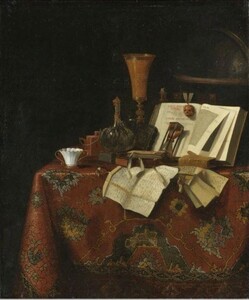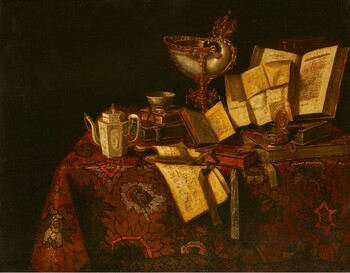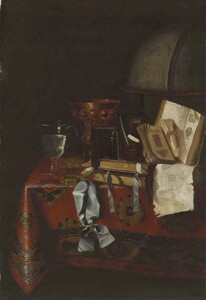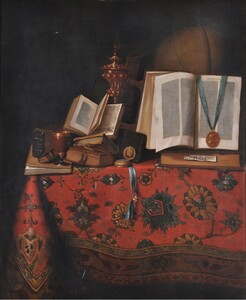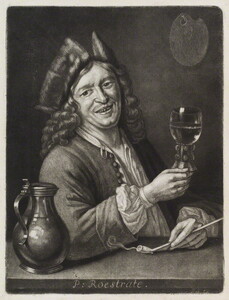4.000 €
Unidentified painter active in London, circa 1700
Vanitas still life
Oil on canvas : 68,3 X 57,4 cm
Unsigned
Frame : 82,9 X 72,0 cm
In short
Between the middle of the 1660s and 1700 the Dutch still life painter Pieter Gerritsz. van Roestraeten had a very successful career in London.
Under the name of the Pseudo-Roestraeten are grouped a number of still lifes painted by local painters who imitated his typical style of precious objects set against a dark background.
About Pieter Gerritsz. van Roestraeten
Dutch painter
Haarlem 1630 – 1700 London
In his early, Dutch years van Roestraeten had painted peasant scenes and portraits. After his move to London, around the middle of the 1660s, he specialised in still lifes; besides these he painted a few self portraits.
He was a pupil of Frans Hals in Haarlem between circa 1646 and 1651.
He entered in 1651 the Guild of Saint Luke of Haarlem as a portrait painter. He soon moved to nearby Amsterdam where he remained until 1659. In 1654 he married there a daughter of Frans Hals’s second marriage, Adriaentje.
Between 1663 and 1666 he moved to London. According to Arnold Houbraken (the painter’s biographer in his “De Groote Schouburgh” of 1718) van Roestraeten was introduced to King Charles II (1630 – 1685) by Sir Peter Lely (1618 – 1680). Lely, who was of Dutch origin (his real name was Pieter van der Faes), was the dominant English portrait painter. Apparently afraid of competition in the field of portraiture, Lely had offered to introduce van Roestraeten to the King on the condition that he ceased painting portraits. Van Roestraeten kept his promise, for there are no further known portraits, other than self-portraits. It seems the King also encouraged van Roestraeten to paint still lifes, at first strongly influenced by Willem Kalf.
Pieter van Roestraeten witnessed the Great Fire of London in September 1666, during which he suffered a severe hip injury. That disaster destroyed almost all the homes of the City’s inhabitants. Van Roestraeten lived in Covent Garden, close to the Palace of Whitehall. In 1693/94 h was recorded in King Street. He was successful and his pictures fetched high prices; he charged his aristocratic patrons 50 pounds per still life. He remained in London until his death in 1700. He was buried at Saint Paul’s church in Covent Garden in London, just like Lely.
Van Roestraeten specialised in the very detailed representation (“portraits”) of precious objects on a dark background. These prized possessions often have a Vanitas content. He seems to have signed his paintings regularly, but he almost never dated them. Except for some of his small, early works, which are painted on panel, van Roestraeten always painted on canvas.
About the Pseudo-Roestraeten
Nothing is known about the workshop practice of Pieter Gerritsz. van Roestraeten. But it is clear that over a career of 35 years in London he must have influenced a number of yet unidentified still life painters. They have been grouped under the invented name of ‘Pseudo-Roestraeten’. There was clearly an eager demand for this type of subjects with precious items, tea sets, books and music instruments. Very often these have been represented on woven carpets, as is also the case here.
Why should you buy this painting?
Because there is more to this mysterious display of precious objects and documents, frozen in time and depicted against a typical dark background, than meets the eye.
Comparative paintings
Click photos for more details

